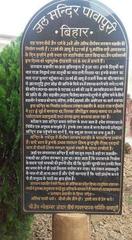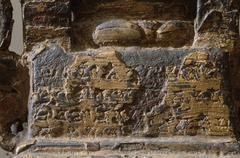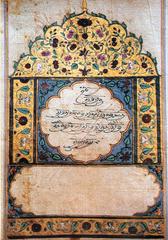Venuvana Vihara: Visiting Hours, Tickets, and Historical Guide to Rajgir’s Buddhist Heritage
Date: 15/06/2025
Introduction
Venuvana Vihara, or the Bamboo Grove Monastery, stands as a serene testament to the Buddhist legacy in Rajgir, Bihar. Established in the 6th century BCE under King Bimbisara of Magadha, it was the first monastery dedicated to Gautama Buddha and his disciples. This pivotal gift marked the beginning of monastic Buddhism, setting the groundwork for spiritual communities across Asia (The Print; Wisdom Library). Today, Venuvana Vihara is not only a religious sanctuary but also a living repository of ancient Indian history, Buddhist culture, and tranquil natural beauty.
This guide provides detailed insights into Venuvana Vihara’s history, religious significance, visiting hours, ticketing policies, facilities, accessibility, nearby attractions, and practical travel tips, ensuring that every visitor—pilgrim, historian, or traveler—enjoys a rewarding experience.
Historical and Religious Significance
Origins and Establishment
Venuvana Vihara was established during the reign of King Bimbisara, who, deeply moved by Buddha’s teachings, donated a bamboo grove for the creation of a monastery (Wisdom Library). Some records suggest that a wealthy supporter, Kalandaka, initially offered the grove, followed by Bimbisara’s construction of monastic buildings (Tibetan Buddhist Encyclopedia). This generous act marked the first land endowment to the Buddhist Sangha, setting an enduring tradition of royal and lay patronage.
Role in Early Buddhism
Buddha spent several monsoon retreats (vassas) at Venuvana Vihara, using it as a base for meditation, teaching, and community organization. It was here that seminal discourses were delivered, shaping the early Buddhist canon (Indianetzone). The site’s proximity to Griddhakuta (Vulture Peak) and Saptaparni Cave further underscores its centrality to Buddhist history (Prepp.in).
Symbolism and Legacy
Venuvana’s establishment marked a significant transition from itinerant asceticism to settled monastic life, fostering scriptural study and communal living. Its story symbolizes the close relationship between the Sangha and its lay supporters, a tradition that shaped Buddhist expansion throughout Asia (Vedics.in).
Pilgrimage and Interfaith Resonance
Today, Venuvana Vihara remains a focal pilgrimage destination, particularly during Buddha Purnima and monsoon retreats, when devotees meditate, offer prayers, and participate in communal rituals (theholidaystory.com). Rajgir’s significance for Hindus, Jains, and Buddhists alike establishes Venuvana as a beacon of religious coexistence and peace.
Site Layout and Key Features
Monastic Complex and Karandak Tank
Excavations have revealed a sprawling monastic layout, comprising numerous courts, meditation halls, and the Karandak Tank—a large pond where the Buddha is believed to have bathed before meditation (Trawell.in). The pond, surrounded by bamboo groves and flowering trees, remains the centerpiece of tranquility at the vihara.
Bamboo Groves and Meditation Zones
The lush bamboo clusters recreate the ancient environment, offering shaded pathways and designated zones for meditation and reflection. The peaceful ambiance is enhanced by local birdlife and the gentle rustle of bamboo, echoing the serenity of Buddha’s time (Cultural India).
Modern Additions and Interpretation
Modern amenities include a small stupa and Buddha statue by the pond, bilingual interpretive signage, and benches for rest. Archaeological remains such as brick foundations and plaques provide historical context.
Visiting Hours, Tickets, and Facilities
Visiting Hours
- Venuvana Vihara is open daily from 6:00 AM to 6:00 PM (Connecting Traveller).
- Early morning visits are ideal for meditation and photography.
Ticket Information
- Indian nationals: INR 5
- Foreign nationals: INR 70
- Children below a certain age often enter free; confirm at the entrance for the latest details.
Accessibility
- Well-paved paths and ramps make the site largely wheelchair-friendly, though some natural areas remain uneven.
- Restrooms, drinking water stations, and shaded seating are available.
- Security personnel and CCTV ensure visitor safety.
Amenities
- A souvenir kiosk operated by Bihar State Tourism offers guidebooks, postcards, and handicrafts (Bihar Tourism).
- Cleanliness and maintenance are priorities, preserving the site’s tranquil atmosphere.
How to Reach Venuvana Vihara
- By Air: Nearest airport is Patna (approx. 100 km); taxis and buses connect to Rajgir.
- By Train: Rajgir railway station (3–5 km from Venuvana) connects to Patna and Gaya.
- By Road: Rajgir is accessible from Patna, Gaya, and Bodh Gaya; private taxis, buses, and rental cars are available (Savaari).
Best Time to Visit
- October to March: Pleasant weather and vibrant gardens (MakeMyTrip).
- Summer (April–June): High temperatures; visit early or late in the day, stay hydrated.
- Monsoon (July–September): Lush scenery, but trails may be slippery—carry rain gear.
- Festivals: Buddha Purnima (April/May) draws crowds for special ceremonies.
Key Attractions and Activities
- Bamboo Grove: The heart of Venuvana, ideal for peaceful walks.
- Karandak Tank: Central pond associated with Buddha’s life.
- Meditation Areas: Designated quiet zones.
- Interpretive Boards: Explore the site’s history and significance.
- Photographic Spots: Early morning and late afternoon offer optimal light.
- Deer Enclosure & Gardens: Engage with the local ecosystem.
Guided Tours, Events, and Educational Programs
- Guided Tours: Available for a nominal fee at the entrance, with local guides providing in-depth historical and cultural context.
- Festivals & Special Events: Buddha Purnima and monsoon retreats feature chanting, meditation sessions, and cultural performances (Buddhist Tourism).
- School/Educational Visits: Programs run in collaboration with local organizations.
Practical Tips for Visitors
- Dress modestly and remove shoes in temple or meditation areas.
- Photography is allowed (no flash inside the temple; drone/commercial use requires permission).
- Carry water, cash in small denominations, and weather-appropriate gear.
- Respect wildlife: Feed animals only in designated areas.
- Maintain silence in meditation zones and avoid littering.
- Check for updated COVID-19 protocols as needed.
Accommodation and Dining
- Where to Stay: Options range from budget guesthouses to eco-resorts such as Pandu Pokhar Eco Adventure Resort, Hotel Bodhi Retreat, and Hotel Saket Palace, with prices from INR 1,000 to INR 6,400 per night (MakeMyTrip).
- Dining Nearby: Green Hotel, Gurunanak Cafeteria, and Annapurna Restaurant offer local and vegetarian cuisine.
Nearby Attractions
- Vishwa Shanti Stupa: 2.4 km, accessible by ropeway.
- Gridhakuta (Vulture’s Peak): 2.2 km, key pilgrimage site.
- Nalanda University Ruins: A UNESCO World Heritage Site.
- Japanese Buddhist Temple, Ashoka Stupa Peak, Rajgir Hot Springs: All within easy reach.
Conservation and Responsible Tourism
Venuvana Vihara is a protected heritage site under the Archaeological Survey of India (ASI). Preservation efforts focus on maintaining ancient structures, bamboo groves, and sustainable tourism. Visitors are urged to respect posted guidelines and support local communities.
Frequently Asked Questions (FAQ)
Q: What are the visiting hours of Venuvana Vihara?
A: Daily from 6:00 AM to 6:00 PM.
Q: How much is the entry fee?
A: INR 5 for Indian nationals, INR 70 for foreign nationals; children often free.
Q: Are guided tours available?
A: Yes, for a nominal fee at the entrance.
Q: Is Venuvana Vihara wheelchair accessible?
A: Most areas are accessible; some natural paths may be uneven.
Q: Can I take photographs?
A: Yes, but avoid flash in the temple; commercial/drone photography requires permission.
Q: When is the best time to visit?
A: October to March for pleasant weather and festivals.
Conclusion
Venuvana Vihara remains a timeless sanctuary where history, spirituality, and nature harmoniously converge. As the birthplace of Buddhist monastic tradition and a living symbol of royal patronage, it offers visitors a unique blend of tranquility, heritage, and inspiration. With well-maintained facilities, accessible pathways, and a welcoming atmosphere, Venuvana Vihara invites all to explore, reflect, and connect with India’s ancient past.
Plan Your Visit
- Download the Audiala app for guided tours, real-time updates, and personalized itineraries.
- Follow us on social media for events, travel tips, and exclusive content about Rajgir’s cultural treasures.
Sources and Official Links
- Rajgir’s Rediscovery Is as Complex as Its History: 12 Archaeologists Unravelled Its Mysteries (The Print)
- Venuvana, Buddhist Monastery, Early Buddhism (Wisdom Library)
- Bamboo Grove Monastery (Venuvana) (Tibetan Buddhist Encyclopedia)
- Venuvana Vihara Archaeology and History (Trawell.in)
- Venuvana Vihara Religious Significance and Visitor Guide (Indianetzone)
- A Tour to Rajgir – Tourist Places & History (Vedics.in)
- Nalanda & Rajgir Tour Plan (TheHolidayStory)
- Venuvana Vihara Tickets, Hours & Travel Guide (Connecting Traveller)
- Venuvana Vihara Rajgir Official Page (Bihar Tourism)
- Savaari – Things to Do in Rajgir
- MakeMyTrip – Best Time to Visit Rajgir
- TravelSetu – Guide to Rajgir Tourism
- Cultural India – Venuvana
- Buddhist Tourism – Venuvana
- Archaeological Survey of India (ASI)
- Incredible India – Venuvana


